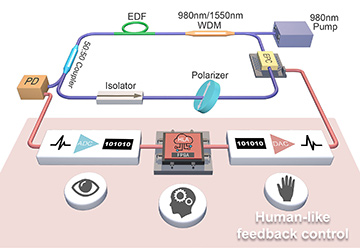 Real-time intelligent mode-locked fiber laser (MLFL). [Enlarge figure]
Real-time intelligent mode-locked fiber laser (MLFL). [Enlarge figure]
The passive mode-locked fiber laser (MLFL) is utilized frequently for industrial applications and scientific research, because of its simple structure and the high quality of the output pulse train. Nonlinear polarization evolution (NPE), with its rich nonlinear dynamics, is the most attractive approach for implementing a passive MLFL. However, the operating status of NPE-based passive MLFL is closely related to polarization. That makes these lasers extremely vulnerable to environmental disturbances, limiting their widespread application. In work this year, our group developed an algorithm with human-like intelligence that can address this problem and expand applications for passive MLFLs.
Several studies have already explored approaches for automatic mode-locking, employing evolutionary algorithms, genetic algorithms, and deep-learning techniques.1–4 However, these algorithms rest on logic that is completely different from the logic that humans bring to the mode-locking tuning process, so the tuning efficiency is quite low. Instead, these implementations spend excessive time on automatic mode-locking, and they cannot recover from detachments quickly. The automatic mode-locking time in several of these studies is around 30 minutes.1,3 A long mode-locking time and a long recovery time from disturbances limit practical applications in engineering.
Our study used a human-like algorithm (HLA) to experimentally demonstrate a real-time, intelligent MLFL that can automatically lock on and switch to fundamental mode-locking (FML), harmonic mode-locking, Q-switching, and Q-switched mode-locking regimes.5 The HLA combines human logic with machine speed and computing capability. In particular, the HLA is endowed with human-like intelligence to guide the laser to quickly lock onto various regimes and to quickly recover from detachments.
Under the HLA approach, the shortest mode-locking time from free running to the FML regime was a mere 0.22 s—400 times shorter than the shortest initial lock time reported to date.2 The HLA’s fastest recovery from vibration-induced detachment (via random collision recovery) takes 14.8 ms, some 2,000 times shorter than the previously reported shortest recovery time.2 The fast recovery time is extremely important for guaranteeing the long-term stability of the MLFL and protecting subsequent devices from damage.
We believe that the intelligent MLFL demonstrated this year could represent a breakthrough in the field of mode-locking fiber lasers, and may let NPE-based MLFL find real applications in both industry and scientific research fields. It also constitutes an example of how artificial-intelligence techniques can improve the performance of optics.
Researchers
Guoqing Pu, Lilin Yi, Li Zhang and Weisheng Hu, Shanghai Jiao Tong University, Shanghai, China
References
1. R.I. Woodward and E.J.R. Kelleher. Sci. Rep. 6, 37616 (2016).
2. D.G. Winters et al. Opt. Express 25, 33216 (2017).
3. U. Andral et al. Optica 2, 275 (2015).
4. T. Baumeister et al. J. Opt. Soc. Am. B 35, 617 (2018).
5. G. Pu et al. Optica 6, 362 (2019).
